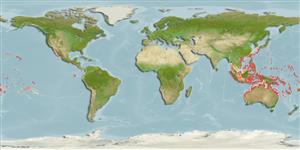>
Eupercaria/misc (Various families in series Eupercaria) >
Labridae (Wrasses) > Corinae
Etymology: Stethojulis: Greek, stetho, stethion = brest; literal = to prick a little breast + Greek, ioulis, a fish dealing with genera Coris or Thalassoma (Ref. 45335).
More on author: Bleeker.
Environment: milieu / climate zone / depth range / distribution range
Ecologia
marinhas associadas(os) a recifes; intervalo de profundidade 0 - 30 m (Ref. 9311). Tropical; 32°N - 32°S, 92°E - 89°W
Indo-Pacific: eastern Indian Ocean to western Australia, including the Christmas Island, Cocos-Keeling and the Andaman Sea; then from Japan to New South Wales, Australia. Eastern Pacific: offshore islands in the eastern Pacific, including Clipperton, Cocos and the Galapagos islands (Ref. 36378). Range extends to Baja California during El Niño (Victor, pers. comm.). Replaced by Stethojulis albovittata in the western Indian Ocean and Stethojulis balteata in the Hawaiian Islands (Ref. 37816).
Tamanho / Peso / Idade
Maturity: Lm ? range ? - ? cm
Max length : 15.0 cm TL macho/indeterminado; (Ref. 30874); 8.0 cm TL (female)
Espinhos dorsais (total): 9; Raios dorsais moles (total): 11-12; Espinhos anais 3; Raios anais moles: 11. 1st spine of the anal fin is minute or imbedded (Ref. 1602).Terminal males typically have a series of partial to complete longitudinal thin blue lines on their sides (Ref. 1602). Females mainly bluish grey with fine white spotting over upper sides and a small red spot at axil of pectoral fin (Ref. 48636).
Usually found in shallow clear water of reef flats and lagoon and seaward reefs, in areas of mixed sand, rubble and coral (Ref. 9710, 58534). Usually solitary or in small groups (Ref. 9311). Feeds mainly on demersal planktonic crustaceans and small benthic invertebrates. Female length is from Ref. 9137. Replaced by S. albovittatus in the Andaman Sea (Ref. 90102). Minimum depth reported taken from Ref. 128797.
Life cycle and mating behavior
Maturidade | Reprodução | Desova | Ovos | Fecundidade | Larvas
Oviparous, distinct pairing during breeding (Ref. 205).
Randall, J.E., 2000. Revision of the Indo-Pacific labrid fishes of the genus Stethojulis, with descriptions of two new species. Indo-Pac. Fish. (31):42 p. (Ref. 36378)
Categoria na Lista Vermelha da IUCN (Ref. 130435)
Ameaça para o homem
Harmless
Utilização humana
Pescarias: pouco comercial; Aquário: Espécies comerciais
Mais informação
ReferênciasAquaculturaPerfil para aquaculturaEstirpesGenéticaElectrophoresesHereditariedadeDoençasProcessamentoNutrientsMass conversion
Ferramentas
Relatórios especiais
Descarregue XML
Fontes da internet
Estimates based on models
Preferred temperature (Ref.
123201): 24.5 - 29.3, mean 28.4 °C (based on 2292 cells).
Phylogenetic diversity index (Ref.
82804): PD
50 = 0.5010 [Uniqueness, from 0.5 = low to 2.0 = high].
Bayesian length-weight: a=0.01000 (0.00561 - 0.01782), b=3.00 (2.85 - 3.15), in cm total length, based on LWR estimates for this species & Genus-body shape (Ref.
93245).
Nível Trófico (Ref.
69278): 3.2 ±0.2 se; based on diet studies.
Resiliência (Ref.
120179): Elevada, tempo mínimo de duplicação da população menor que 15 meses (Preliminary K or Fecundity.).
Fishing Vulnerability (Ref.
59153): Low vulnerability (10 of 100).
Nutrients (Ref.
124155): Calcium = 90.1 [53.3, 149.7] mg/100g; Iron = 0.741 [0.435, 1.371] mg/100g; Protein = 18.4 [15.5, 20.5] %; Omega3 = 0.152 [0.098, 0.236] g/100g; Selenium = 24 [15, 42] μg/100g; VitaminA = 137 [43, 504] μg/100g; Zinc = 1.82 [1.27, 2.91] mg/100g (wet weight);
